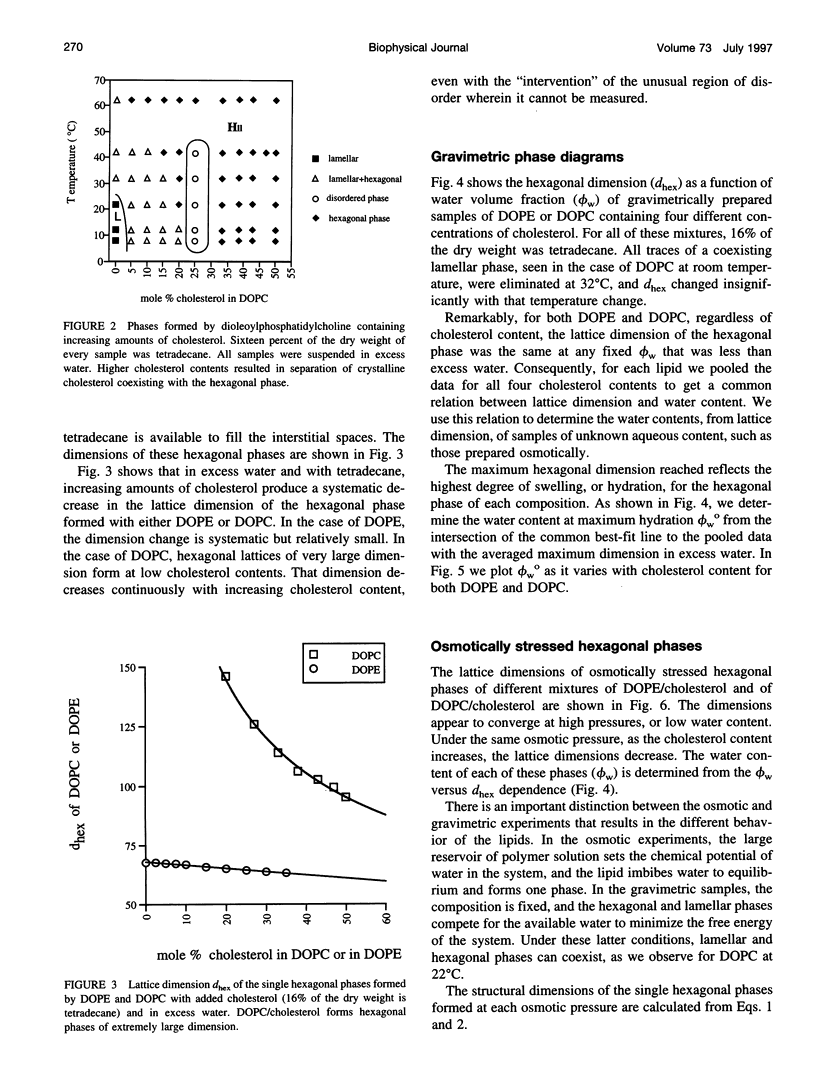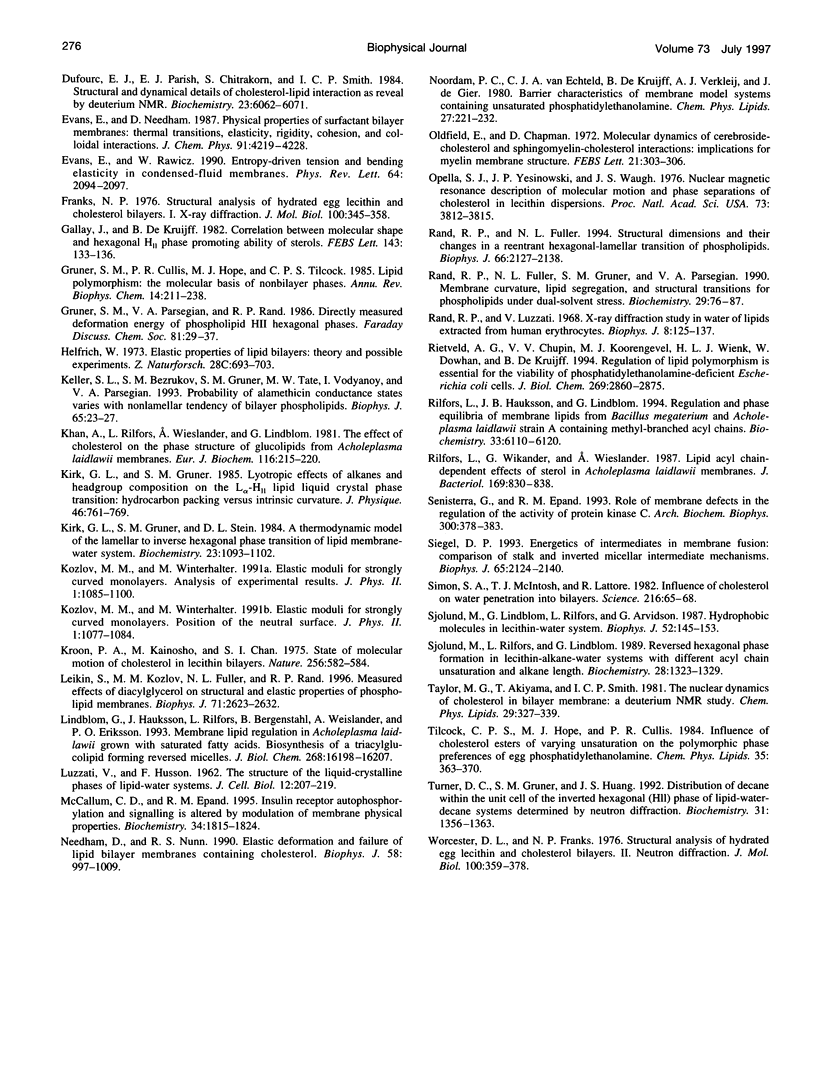Abstract
The behavior of dioleoylphosphatidylethanolamine (DOPE)/cholesterol/tetradecane and dioleoylphosphatidylcholine (DOPC)/cholesterol/tetradecane were examined using x-ray diffraction and the osmotic stress method. DOPE/tetradecane, with or without cholesterol, forms inverted hexagonal (HII) phases in excess water. DOPC/tetradecane forms lamellar phases without cholesterol at lower temperatures. With tetradecane, as little as 5 mol% cholesterol in DOPC induced the formation of HII phases of very large dimension. Increasing levels of cholesterol result in a systematic decrease in the HII lattice dimension for both DOPE and DOPC in excess water. Using osmotic pressure to control hydration, we applied a recent prescription to estimate the intrinsic curvature and bending modulus of the HII monolayers. The radii of the intrinsic curvature, RPO, at a pivotal plane of constant area within the monolayer were determined to be 29.4 A for DOPE/tetradecane at 22 degrees C, decreasing to 27 A at 30 mol% cholesterol. For DOPC/tetradecane at 32 degrees C, RPO decreased from 62.5 A to 40 A as its cholesterol content increased from 30 to 50 mol%. These data yielded an estimate of the intrinsic radius of curvature for pure DOPC of 87.3 A. The bending moduli kc of DOPE/tetradecane and DOPC/tetradecane, each with 30 mol% cholesterol, are 15 and 9 kT, respectively. Tetradecane itself was shown to have little effect on the bending modulus in the cases of DOPE and cholesterol/DOPE. Surprisingly, cholesterol effected only a modest increase in the kc of these monolayers, which is much smaller than estimated from its effect on the area compressibility modulus in bilayers. We discuss possible reasons for this difference.
Full text
PDF









Selected References
These references are in PubMed. This may not be the complete list of references from this article.
- Bittman R., Clejan S., Lund-Katz S., Phillips M. C. Influence of cholesterol on bilayers of ester- and ether-linked phospholipids. Permeability and 13C-nuclear magnetic resonance measurements. Biochim Biophys Acta. 1984 May 16;772(2):117–126. doi: 10.1016/0005-2736(84)90034-8. [DOI] [PubMed] [Google Scholar]
- Cheng K. H., Lepock J. R., Hui S. W., Yeagle P. L. The role of cholesterol in the activity of reconstituted Ca-ATPase vesicles containing unsaturated phosphatidylethanolamine. J Biol Chem. 1986 Apr 15;261(11):5081–5087. [PubMed] [Google Scholar]
- Chernomordik L., Kozlov M. M., Zimmerberg J. Lipids in biological membrane fusion. J Membr Biol. 1995 Jul;146(1):1–14. doi: 10.1007/BF00232676. [DOI] [PubMed] [Google Scholar]
- Cooper R. A., Leslie M. H., Fischkoff S., Shinitzky M., Shattil S. J. Factors influencing the lipid composition and fluidity of red cell membranes in vitro: production of red cells possessing more than two cholesterols per phospholipid. Biochemistry. 1978 Jan 24;17(2):327–331. doi: 10.1021/bi00595a021. [DOI] [PubMed] [Google Scholar]
- Coorssen J. R., Rand R. P. Effects of cholesterol on the structural transitions induced by diacylglycerol in phosphatidylcholine and phosphatidylethanolamine bilayer systems. Biochem Cell Biol. 1990 Jan;68(1):65–69. doi: 10.1139/o90-008. [DOI] [PubMed] [Google Scholar]
- Cornell R. B. Regulation of CTP:phosphocholine cytidylyltransferase by lipids. 2. Surface curvature, acyl chain length, and lipid-phase dependence for activation. Biochemistry. 1991 Jun 18;30(24):5881–5888. doi: 10.1021/bi00238a011. [DOI] [PubMed] [Google Scholar]
- Cullis P. R., De Kruijff B. Polymorphic phase behaviour of lipid mixtures as detected by 31P NMR. Evidence that cholesterol may destabilize bilayer structure in membrane systems containing phosphatidylethanolamine. Biochim Biophys Acta. 1978 Feb 21;507(2):207–218. doi: 10.1016/0005-2736(78)90417-0. [DOI] [PubMed] [Google Scholar]
- Dekker C. J., Geurts van Kessel W. S., Klomp J. P., Pieters J., De Kruijff B. Synthesis and polymorphic phase behaviour of polyunsaturated phosphatidylcholines and phosphatidylethanolamines. Chem Phys Lipids. 1983 Jul;33(1):93–106. doi: 10.1016/0009-3084(83)90012-9. [DOI] [PubMed] [Google Scholar]
- Demel R. A., Jansen J. W., van Dijck P. W., van Deenen L. L. The preferential interaction of cholesterol with different classes of phospholipids. Biochim Biophys Acta. 1977 Feb 14;465(1):1–10. doi: 10.1016/0005-2736(77)90350-9. [DOI] [PubMed] [Google Scholar]
- Evans E, Rawicz W. Entropy-driven tension and bending elasticity in condensed-fluid membranes. Phys Rev Lett. 1990 Apr 23;64(17):2094–2097. doi: 10.1103/PhysRevLett.64.2094. [DOI] [PubMed] [Google Scholar]
- Franks N. P. Structural analysis of hydrated egg lecithin and cholesterol bilayers. I. X-ray diffraction. J Mol Biol. 1976 Jan 25;100(3):345–358. doi: 10.1016/s0022-2836(76)80067-8. [DOI] [PubMed] [Google Scholar]
- Gallay J., De Kruijff B. Correlation between molecular shape and hexagonal HII phase promoting ability of sterols. FEBS Lett. 1982 Jun 21;143(1):133–136. doi: 10.1016/0014-5793(82)80289-5. [DOI] [PubMed] [Google Scholar]
- Gruner S. M., Cullis P. R., Hope M. J., Tilcock C. P. Lipid polymorphism: the molecular basis of nonbilayer phases. Annu Rev Biophys Biophys Chem. 1985;14:211–238. doi: 10.1146/annurev.bb.14.060185.001235. [DOI] [PubMed] [Google Scholar]
- Gruner S. M., Parsegian V. A., Rand R. P. Directly measured deformation energy of phospholipid HII hexagonal phases. Faraday Discuss Chem Soc. 1986;(81):29–37. doi: 10.1039/dc9868100029. [DOI] [PubMed] [Google Scholar]
- Helfrich W. Elastic properties of lipid bilayers: theory and possible experiments. Z Naturforsch C. 1973 Nov-Dec;28(11):693–703. doi: 10.1515/znc-1973-11-1209. [DOI] [PubMed] [Google Scholar]
- Keller S. L., Bezrukov S. M., Gruner S. M., Tate M. W., Vodyanoy I., Parsegian V. A. Probability of alamethicin conductance states varies with nonlamellar tendency of bilayer phospholipids. Biophys J. 1993 Jul;65(1):23–27. doi: 10.1016/S0006-3495(93)81040-3. [DOI] [PMC free article] [PubMed] [Google Scholar]
- Khan A., Rilfors L., Wieslander A., Lindblom G. The effect of cholesterol on the phase structure of glucolipids from Acholeplasma laidlawii membranes. Eur J Biochem. 1981 May;116(2):215–220. doi: 10.1111/j.1432-1033.1981.tb05321.x. [DOI] [PubMed] [Google Scholar]
- Kroon P. A., Kainosho M., Chan S. I. State of molecular motion of cholesterol in lecithin bilayers. Nature. 1975 Aug 14;256(5518):582–584. doi: 10.1038/256582a0. [DOI] [PubMed] [Google Scholar]
- LUZZATI V., HUSSON F. The structure of the liquid-crystalline phasis of lipid-water systems. J Cell Biol. 1962 Feb;12:207–219. doi: 10.1083/jcb.12.2.207. [DOI] [PMC free article] [PubMed] [Google Scholar]
- Leikin S., Kozlov M. M., Fuller N. L., Rand R. P. Measured effects of diacylglycerol on structural and elastic properties of phospholipid membranes. Biophys J. 1996 Nov;71(5):2623–2632. doi: 10.1016/S0006-3495(96)79454-7. [DOI] [PMC free article] [PubMed] [Google Scholar]
- Lindblom G., Hauksson J. B., Rilfors L., Bergenståhl B., Wieslander A., Eriksson P. O. Membrane lipid regulation in Acholeplasma laidlawii grown with saturated fatty acids. Biosynthesis of a triacylglucolipid forming reversed micelles. J Biol Chem. 1993 Aug 5;268(22):16198–16207. [PubMed] [Google Scholar]
- McCallum C. D., Epand R. M. Insulin receptor autophosphorylation and signaling is altered by modulation of membrane physical properties. Biochemistry. 1995 Feb 14;34(6):1815–1824. doi: 10.1021/bi00006a001. [DOI] [PubMed] [Google Scholar]
- Needham D., Nunn R. S. Elastic deformation and failure of lipid bilayer membranes containing cholesterol. Biophys J. 1990 Oct;58(4):997–1009. doi: 10.1016/S0006-3495(90)82444-9. [DOI] [PMC free article] [PubMed] [Google Scholar]
- Noordam P. C., van Echteld C. J., de Kruijff B., Verkleij A. J., de Gier J. Barrier characteristics of membrane model systems containing unsaturated phosphatidylethanolamines. Chem Phys Lipids. 1980 Oct;27(3):221–232. doi: 10.1016/0009-3084(80)90037-7. [DOI] [PubMed] [Google Scholar]
- Oldfield E., Chapman D. Molecular dynamics of cerebroside-cholesterol and sphingomyelin-cholesterol interactions: Implications for myelin membrane structure. FEBS Lett. 1972 Apr 1;21(3):303–306. doi: 10.1016/0014-5793(72)80189-3. [DOI] [PubMed] [Google Scholar]
- Opella S. J., Yesinowski J. P., Waugh J. S. Nuclear magnetic resonance description of molecular motion and phase separations of cholesterol in lecithin dispersions. Proc Natl Acad Sci U S A. 1976 Nov;73(11):3812–3815. doi: 10.1073/pnas.73.11.3812. [DOI] [PMC free article] [PubMed] [Google Scholar]
- Rand R. P., Fuller N. L., Gruner S. M., Parsegian V. A. Membrane curvature, lipid segregation, and structural transitions for phospholipids under dual-solvent stress. Biochemistry. 1990 Jan 9;29(1):76–87. doi: 10.1021/bi00453a010. [DOI] [PubMed] [Google Scholar]
- Rand R. P., Fuller N. L. Structural dimensions and their changes in a reentrant hexagonal-lamellar transition of phospholipids. Biophys J. 1994 Jun;66(6):2127–2138. doi: 10.1016/S0006-3495(94)81008-2. [DOI] [PMC free article] [PubMed] [Google Scholar]
- Rand R. P., Luzzati V. X-ray diffraction study in water of lipids extracted from human erythrocytes: the position of cholesterol in the lipid lamellae. Biophys J. 1968 Jan;8(1):125–137. doi: 10.1016/S0006-3495(68)86479-3. [DOI] [PMC free article] [PubMed] [Google Scholar]
- Rilfors L., Hauksson J. B., Lindblom G. Regulation and phase equilibria of membrane lipids from Bacillus megaterium and Acholeplasma laidlawii strain A containing methyl-branched acyl chains. Biochemistry. 1994 May 24;33(20):6110–6120. doi: 10.1021/bi00186a010. [DOI] [PubMed] [Google Scholar]
- Rilfors L., Wikander G., Wieslander A. Lipid acyl chain-dependent effects of sterols in Acholeplasma laidlawii membranes. J Bacteriol. 1987 Feb;169(2):830–838. doi: 10.1128/jb.169.2.830-838.1987. [DOI] [PMC free article] [PubMed] [Google Scholar]
- Senisterra G., Epand R. M. Role of membrane defects in the regulation of the activity of protein kinase C. Arch Biochem Biophys. 1993 Jan;300(1):378–383. doi: 10.1006/abbi.1993.1051. [DOI] [PubMed] [Google Scholar]
- Siegel D. P. Energetics of intermediates in membrane fusion: comparison of stalk and inverted micellar intermediate mechanisms. Biophys J. 1993 Nov;65(5):2124–2140. doi: 10.1016/S0006-3495(93)81256-6. [DOI] [PMC free article] [PubMed] [Google Scholar]
- Simon S. A., McIntosh T. J., Latorre R. Influence of cholesterol on water penetration into bilayers. Science. 1982 Apr 2;216(4541):65–67. doi: 10.1126/science.7063872. [DOI] [PubMed] [Google Scholar]
- Sjölund M., Lindblom G., Rilfors L., Arvidson G. Hydrophobic molecules in lecithin-water systems. I. Formation of reversed hexagonal phases at high and low water contents. Biophys J. 1987 Aug;52(2):145–153. doi: 10.1016/S0006-3495(87)83202-2. [DOI] [PMC free article] [PubMed] [Google Scholar]
- Sjölund M., Rilfors L., Lindblom G. Reversed hexagonal phase formation in lecithin-alkane-water systems with different acyl chain unsaturation and alkane length. Biochemistry. 1989 Feb 7;28(3):1323–1329. doi: 10.1021/bi00429a057. [DOI] [PubMed] [Google Scholar]
- Turner D. C., Gruner S. M., Huang J. S. Distribution of decane within the unit cell of the inverted hexagonal (HII) phase of lipid-water-decane systems determined by neutron diffraction. Biochemistry. 1992 Feb 11;31(5):1356–1363. doi: 10.1021/bi00120a010. [DOI] [PubMed] [Google Scholar]
- Worcester D. L., Franks N. P. Structural analysis of hydrated egg lecithin and cholesterol bilayers. II. Neutrol diffraction. J Mol Biol. 1976 Jan 25;100(3):359–378. doi: 10.1016/s0022-2836(76)80068-x. [DOI] [PubMed] [Google Scholar]


